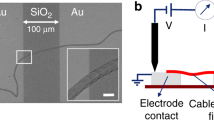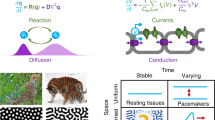Abstract
IN a recent number of NATURE (vol. x. p. 519) the reviewer of “The Protoplasmic Theory of Life” states broadly that few physiologists will agree with the statement in the book that the nerves are not better fitted for the conduction of electric currents than the other moist tissues, and that they possess no demonstrable apparatus for insulation of these currents. There must be some misunderstanding here, for I have adduced proofs from Dubois-Reymond, Ranke, Fick, and others, and I believe all physiologists of note concur in the view as represented by me. The reviewer has apparently overlooked the circumstance that one of the principal points in the chapter was the distinction of the conveyance by nerves of the stimulus caused by electricity, and the mere conduction of an electric current, for he says “there is not the least doubt that it is through the nerve-fibres that electric stimulation will most readily and most powerfully affect muscular fibres at a distance.” No one, I imagine, does doubt this, but it is not at all the same thing as saying that the nerve is the best medium for affecting the muscle owing to its superior power of conducting electricity, for it may also mean that the nerve is susceptible to the stimulus of electricity. This is, indeed, sufficiently shown by the fact that a mechanical stimulation of the nerve will have a similar effect, while we do not attribute to the nerve any superior power of conducting mechanical force. Permit me to refer to the additional light thrown on the question in the recently published work of Prof. Vulpian (“Lecons sur d'Ap-pareil Vaso-moteur,” 1875). It had been asserted by Legros and Onimus, that on passing a galvanic current through a nerve containing vaso-motcr filaments, the ascending current caused contraction, while the descending ones produced dilatation of the capillary arteries. The experiments of Vulpian and Carville yielded results not in accordance with this statement, and both currents were found to cause contraction. Vulpian explains this discrepancy by pointing out that Legros and Onimus assumed to act on particular nerves by sending the current through the skin and subjacent parts. “Not only,” says Vulpian, “are we not authorised to believe that we act on these nerves by this mode, but, in addition, it is evident that we determine excitation of all the tissues comprehended in the current, the skin among others, and that that excitation may provoke reflex vascular dilatations which complicate the results” (p. 114). To perform the experiment properly, it is necessary to secure isolation artificially by cutting the channels of reflex vaso-motor action. Again, it you electrify the sciatic nerve in a dog which has been curarised, no contraction of the voluntary muscles to which it is distributed takes place. And in paralysis of the radial nerve in man from cold, the power of volition over the muscles supplied by it is lost, while the sensory and vaso-motor filaments bound up in the same nerve retain their functional activity. In those cases the power of conducting electricity is not impaired, nor is it indeed in the dead body even; but here, as expressed by Vulpian, “the musculo-motor filaments have lost their normal aptitude to cause the muscular bundles to pass from the state of repose to the state of activity” (p. 122). What that “normal aptitude” consists in is still a question, but it is certainly not the power of conducting electricity, although a knowledge of the latter is of great importance in judging of Dr. Beale's theory of muscular contraction, Dr. Beale, as is well known, still holds to the opinion that the nerve-force is electricity, and that the nerves have not only the power of conducting electricity but of evolving it as a vital act on stimulation from the little masses of protoplasm, bioplasm, or living matter with which the nerve-cords are studded. Although there are many objections to this theory, still the badly-conducting power of the nerves for electricity does not appear an insuperable one when we think of the nerve-force merely as a stimulus, for the quantity of a stimulus necessary to rouse up vital action bears an infinitesimally small proportion to the result. But when the same force is assumed to be the efficient cause of muscular contraction, the question assumes a very different aspect. In Dr. Beale's theory the muscular fibre proper is held not to contain protoplasm, and to be incapable of living action or of evolving force, the contraction being produced by inductive electric action on the sarcous particles, which causes them to change their position and thus approximate the ends of the muscular fibre. The source of the electricity is said to be the protoplasm masses contained in the muscles, in continuous contact with the motor nerves, and it is conveyed to the muscular fibres by loops of fine nerve-fibres crossing them in various directions. In this theory, even supposing insulation to be complete, it is obvious that the conducting power of the nerve-fibre becomes of supreme importance, because not the stimulus only, but the whole force of muscular motion, must be conveyed by it. Now, the nerve-cords do conduct electricity certainly, but so many million times worse than metallic wires, that the loss of energy by transformation into heat must be enormous. Such a loss is inconsistent with the economy of nature and with the actual facts; therefore, unless the nerve-force is a specific force different from surface-electricity, galvanism, and magnetism, though analogous to them, and probably easily convertible into electricity, Dr. Beale's theory cannot be upheld. I have not yet seen any reply by Dr. Beale to this objection.
This is a preview of subscription content, access via your institution
Access options
Subscribe to this journal
Receive 51 print issues and online access
$199.00 per year
only $3.90 per issue
Buy this article
- Purchase on Springer Link
- Instant access to full article PDF
Prices may be subject to local taxes which are calculated during checkout
Similar content being viewed by others
Author information
Authors and Affiliations
Rights and permissions
About this article
Cite this article
DRYSDALE, J. Electric Conductivity of Nerves. Nature 11, 247–248 (1875). https://doi.org/10.1038/011247b0
Issue Date:
DOI: https://doi.org/10.1038/011247b0
Comments
By submitting a comment you agree to abide by our Terms and Community Guidelines. If you find something abusive or that does not comply with our terms or guidelines please flag it as inappropriate.



